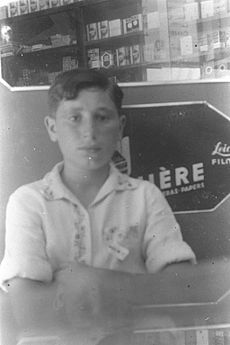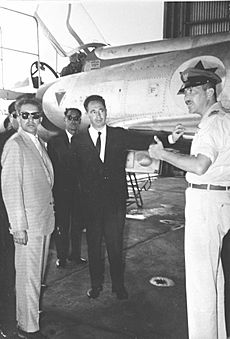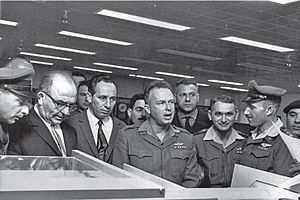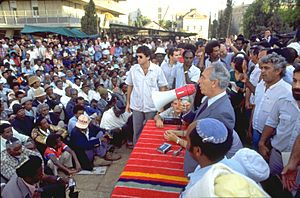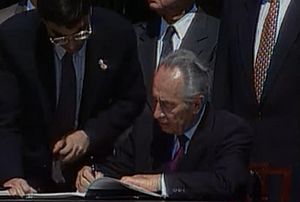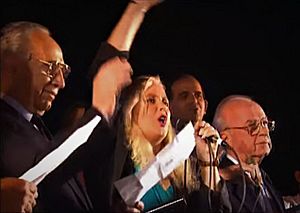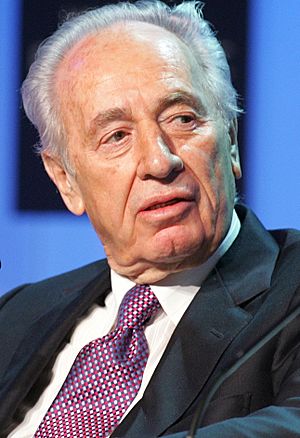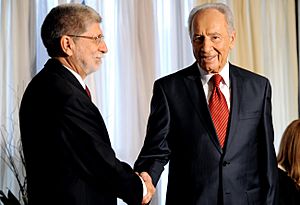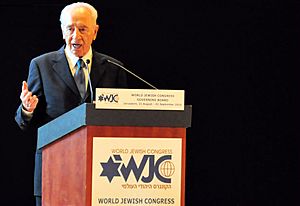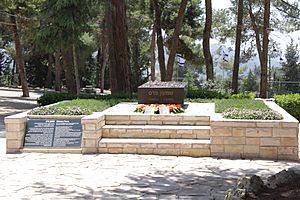Shimon Peres facts for kids
Quick facts for kids
Shimon Peres
|
|
|---|---|
|
שמעון פרס
|
|
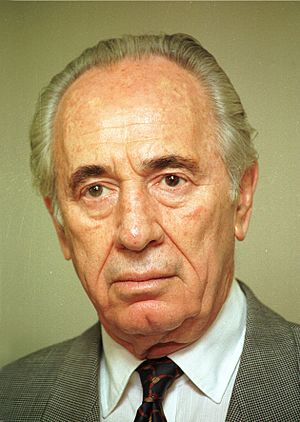
Peres in 1996
|
|
| 9th President of Israel | |
| In office 15 July 2007 – 24 July 2014 |
|
| Prime Minister | |
| Preceded by | Moshe Katsav |
| Succeeded by | Reuven Rivlin |
| 8th Prime Minister of Israel | |
| In office 4 November 1995 – 18 June 1996 |
|
| President | Ezer Weizman |
| Preceded by | Yitzhak Rabin |
| Succeeded by | Benjamin Netanyahu |
| In office 13 September 1984 – 20 October 1986 |
|
| President | Chaim Herzog |
| Preceded by | Yitzhak Shamir |
| Succeeded by | Yitzhak Shamir |
| Acting 22 April – 21 June 1977 |
|
| President | Ephraim Katzir |
| Preceded by | Yitzhak Rabin |
| Succeeded by | Menachem Begin |
| Major ministerial roles | |
| 1969–1970 | Minister of Immigrant Absorption |
| 1970–1974 | Minister of Communications |
| 1970–1974 | Minister of Transportation |
| 1974–1977 | Minister of Information |
| 1974–1977 | Minister of Defense |
| 1984 | Minister of Internal Affairs |
| 1984 | Minister of Religious Affairs |
| 1986–1988 | Minister of Foreign Affairs |
| 1988–1990 | Minister of Finance |
| 1992–1995 | Minister of Foreign Affairs |
| 1995–1996 | Minister of Defense |
| 2001–2002 | Minister of Foreign Affairs |
| Member of the Knesset | |
| In office March 2006–13 June 2007 November 1959–15 January 2006 |
|
| Personal details | |
| Born |
Szymon Perski
2 August 1923 Wiszniew, Poland (now Vishnyeva, Belarus) |
| Died | 28 September 2016 (aged 93) Ramat Gan, Israel |
| Resting place | Mount Herzl, Jerusalem |
| Nationality | Israeli |
| Political party | |
| Other political affiliations |
Alignment (1965–1991) |
| Spouse |
Sonya Gelman
(m. 1945; died 2011) |
| Relations | Lauren Bacall (cousin) Uzi Peres (nephew) |
| Children |
|
| Alma mater | |
| Awards | Nobel Peace Prize (1994) |
| Signature | |
| Military service | |
| Allegiance | Israel |
| Branch/service |
|
| a. | |
Shimon Peres (born Szymon Perski; 2 August 1923 – 28 September 2016) was an important Israeli politician. He served as the prime minister twice, from 1984 to 1986 and again from 1995 to 1996. He also served as the ninth president of Israel from 2007 to 2014.
Peres was involved in Israeli politics for 70 years. He was a member of many government cabinets and represented five different political parties. He was elected to the Knesset (Israel's parliament) in 1959. He served in the Knesset for 48 years, making him the longest-serving member in its history. When he retired in 2014, he was the world's oldest head of state. He was also seen as one of the last leaders from Israel's founding generation.
Peres was known for his speaking skills from a young age. He was a close helper to David Ben-Gurion, who was Israel's first leader. Peres started his political journey in the late 1940s. He held important roles in defense and diplomacy during and after the 1948 Arab–Israeli War. He became the deputy director general of defense in 1952 when he was only 28. He later became the director general of the Ministry of Defense.
In 1994, Peres won the Nobel Peace Prize along with Yitzhak Rabin and Yasser Arafat. This was for their work on the Oslo Accords, which were peace talks with the Palestinian leadership. In 1996, he started the Peres Center for Peace. This center aims to help bring lasting peace and progress to the Middle East. Shimon Peres passed away in 2016 after suffering a stroke.
Contents
- Early Life and Education
- Director General of the Ministry of Defense (1953-1959)
- Early Knesset Career (1959–1974)
- Minister of Defense (1974–1977)
- Acting Prime Minister (1977)
- Labor in Opposition (1977–1984)
- Grand Coalition Government (1984–1988)
- Minister of Finance (1988–1990)
- Labor in Opposition (1990–1992)
- Minister of Foreign Affairs (1992–1995)
- Second Time as Prime Minister (1995–1996)
- Labor in Opposition (1996–1999)
- Minister of Regional Cooperation (1999–2001)
- Minister of Foreign Affairs (2001–2002)
- Labor in Opposition (2002–2005)
- Vice Prime Minister (2005)
- Leaving Labor and Joining Kadima
- President of Israel (2007–2014)
- Post-Presidency and Death
- Political Views and Legacy
- Personal Life and Family
- Places Named After Peres
- Published Works
- Awards and Recognition
- Overview of Offices Held
- Images for kids
- See also
Early Life and Education
Shimon Peres was born Szymon Perski on 2 August 1923, in a town called Wiszniew, which was then in Poland. Today, this town is in Belarus. His parents were Yitzhak and Sara. At home, his family spoke Hebrew, Yiddish, and Russian. Peres also learned Polish at school, and later English and French. His father was a businessman. Peres had a younger brother named Gershon. He was also related to the famous American actress Lauren Bacall.
In 1932, Peres's father moved to Mandatory Palestine (which is now Israel). The rest of the family followed him in 1934. Shimon went to school in Tel Aviv. When he was 15, he moved to an agricultural school called Ben Shemen. He lived and worked on a Kibbutz (a community farm) for several years. Peres was one of the people who helped start Kibbutz Alumot.
In 1941, he became the Secretary of a youth movement called HaNoar HaOved VeHaLomed. This group was for young people who supported Labor Zionism. In 1944, he returned to Alumot and worked as a farmer and shepherd.
When he was 20, he was chosen for the national leadership of his youth movement. The head of the Mapai party, David Ben-Gurion, noticed him and appointed him to the party's leadership team.
In 1944, Peres led a trip into the Negev desert, which was a restricted area. The group was arrested by British officers. All of them were jailed for two weeks. As the leader, Peres also had to pay a large fine. During this trip, the group found a nest of bearded vultures, which are called peres in Hebrew. From this, Shimon took his Hebrew name, Peres.
Sadly, all of Peres's relatives who stayed in Wiszniew were killed during the Holocaust in 1941.
In 1945, Peres married Sonya Gelman. They had three children: Tsvia, Yoni, and Chemi. Sonya preferred to stay out of the public eye.
In 1947, Peres joined the Haganah, which was the main Jewish defense group before Israel became a country. When Israel gained independence in 1948, David Ben-Gurion put Peres in charge of buying weapons and managing personnel.
In the early 1950s, Peres was the director of the Defense Ministry's team in the United States. While there, he studied English, economics, and philosophy at different universities. He also took a special management course at Harvard University.
Director General of the Ministry of Defense (1953-1959)
In 1952, Peres became the deputy director general of the Ministry of Defense. The next year, he was promoted to director general. At 29, he was the youngest person to hold this important job. He was key in buying weapons and creating strong alliances for Israel. He helped build close ties with France, which led to Israel getting many high-quality weapons. This helped change the balance of power in the region.
Peres played a big part in setting up the Dimona nuclear reactor in Israel. He also helped create a three-country agreement with France and the United Kingdom. This agreement was important for the 1956 Suez Crisis. Peres continued to be a main link in the strong French-Israeli alliance.
The 1956 Suez Crisis
As director general of the Ministry of Defense, Peres was involved in planning the 1956 Suez War. This was a joint effort with France and Britain. Peres went to Paris for secret meetings with the French government. He was important in making the agreement for a military attack.
In 1955, France started sending many weapons to Israel. By April 1956, France agreed to send even more weapons. During this time, Peres told the French that Israel had decided to go to war with Egypt in 1956. France and Israel had a very close relationship in the 1950s, working together on defense and diplomacy. For his work, Peres received a high French award, the Legion of Honour.
At a meeting in Sèvres, Peres helped plan the operation with British and French officials. They agreed that Israel would invade the Sinai. Then, Britain and France would step in, pretending to separate the fighting forces. They would tell both sides to move away from the Suez Canal. The plan was for Britain and France to then argue that Egypt's control of the canal was too weak. They would say it needed to be managed by Britain and France. The three allies mostly achieved their military goals. However, the United States and the Soviet Union strongly opposed the Suez Crisis. This forced Britain and France to pull back, and they failed to gain control of the Suez Canal.
Early Knesset Career (1959–1974)
Peres was first elected to the Knesset in 1959. He was a member of the Mapai party. He became the deputy minister of defense and held this job until 1965. In this role, he talked with U.S. President John F. Kennedy. These talks led to the sale of Hawk anti-aircraft missiles to Israel. This was the first time the U.S. sold military equipment to Israel.
In 1965, Peres left the government because of disagreements between Prime Minister Eshkol and former Prime Minister Ben-Gurion. Peres supported Ben-Gurion. He then helped Ben-Gurion form a new party called Rafi. In 1968, Rafi joined with Mapai to create the Israeli Labor Party. The Labor Party then joined a group called the Alignment.
In 1969, Peres became the Minister of Immigrant Absorption. In 1970, he also became the Minister of Transportation and Communications. After that, he served as Minister of Information.
Minister of Defense (1974–1977)
Peres was appointed Minister of Defense in 1974. This happened after he had competed with Yitzhak Rabin to become the leader of the Labor Party. Rabin became Prime Minister, and Peres took on the defense role.
The 1976 Entebbe Rescue Operation
On 27 June 1976, Peres, as Minister of Defense, worked with Prime Minister Rabin to respond to a terrorist attack. Hijackers took 248 travelers hostage on an Air France plane. The plane was flown to Uganda, Africa, which was 2,000 miles away.
Peres and Rabin approved what became known as "Operation Entebbe." This daring rescue mission took place on 4 July 1976. The mission greatly increased the public's support for Rabin's government. The only Israeli soldier killed during the successful rescue was the commander, Lieutenant Colonel Yonatan Netanyahu, who was the older brother of Benjamin Netanyahu.
Before Rabin approved the mission, he and Peres had different ideas. Rabin was open to releasing Palestinian militants if there was no military option. Peres, however, believed that giving in would encourage more terrorism. He strongly felt a rescue operation should be planned.
Peres put together a secret committee to create a rescue plan. When a plan was ready, he met with commander Netanyahu several times. Peres later said Netanyahu's explanation was "exactitude and imagination." Netanyahu seemed confident the operation would succeed with almost no losses. Peres then got approval from other key military leaders. Finally, he convinced Rabin, who had been hesitant, to approve the plan.
After the mission, Rabin said, "the honor of the Jewish people, their destinies, are challenged and what we are considering is not just a calculated risk in the military sense, but a comparative risk, which exists between surrender to terror and daring rescue stemming from independence."
Acting Prime Minister (1977)
On 8 April 1977, Prime Minister Rabin announced he was stepping down. Peres became a candidate to replace him as the new Labor Party leader. On 10 April 1977, the Labor Party chose Peres as their new leader.
Rabin officially left his role as prime minister on 22 April 1977. Peres then became Israel's unofficial acting prime minister. He couldn't be officially named prime minister because the government was a temporary one.
In his first election as party leader, Peres led the Labor Party to its first-ever election loss. The Likud party, led by Menachem Begin, won. When the new Likud-led government was formed on 20 June 1977, Peres's time as acting prime minister ended.
Labor in Opposition (1977–1984)
When the Likud-led government took power, the Labor Party became the opposition. Peres took on the unofficial role of Knesset opposition leader.
In 1978, Peres was elected vice president of Socialist International. This role allowed him to become friends with foreign politicians from Europe, Africa, and Asia.
Peres easily won re-election as Labor Party leader in 1980. He led his party to another, but closer, loss in the 1981 elections.
Grand Coalition Government (1984–1988)
In the 1984 elections, Peres's Alignment coalition won the most seats. However, they didn't win enough to form a government on their own. So, the Alignment and Likud parties agreed to a special "rotation" arrangement. For the first two years, Peres would be prime minister, and Likud leader Yitzhak Shamir would be foreign minister. Then, they would switch roles for the second half of the term.
First Time as Prime Minister (1984–1986)
Peres was seen as a popular prime minister during his two years in this role. He also held the position of Minister of Religious Affairs for a time.
Military and International Policy
One important event during his first time as prime minister was Operation Wooden Leg. This was a long-range Israeli airstrike against the PLO headquarters in Tunisia. He also made a trip to Morocco to meet with King Hassan II.
In 1985, Peres supported pulling Israeli troops back from Beirut. This was part of a plan to secure Israel's southern border with Lebanon.
Economic Stabilization Plan
A major decision during Peres's first time as prime minister was the 1985 Israel Economic Stabilization Plan.
By 1985, Israel's economy was in trouble. There was very high inflation (prices rising quickly), a large government debt, and foreign money reserves were shrinking fast. With help from the United States, Peres put together a team of American economists to advise him. The U.S. offered $750 million in emergency aid each year for two years, but only if Peres made big changes.
Peres was at first unsure about taking such strong steps. These changes could be unpopular and might cause many people to lose their jobs. But he was convinced to go ahead with the plan. His cabinet quickly approved the plan on 1 July 1985. This program quickly helped the Israeli economy. By the end of the year, inflation dropped a lot. The Israeli currency became stable, and the government balanced its budget. Even though Israel later had a small recession, this plan is seen as a very successful way to fix an economy in crisis. It is credited with saving the nation's economy.
Minister of Foreign Affairs (1986–1988)
As part of the rotation agreement, Peres and Shamir switched roles in 1986. Shamir became prime minister, and Peres became foreign minister. During this government, Peres was also the designated acting prime minister of Israel.
Minister of Finance (1988–1990)
In 1988, Peres's Alignment party lost another election, but by a small margin. Peres agreed to form another grand coalition government with the Likud party. This time, Shamir would be prime minister for the whole term. In this government (1988–90), Peres served as Minister of Finance. He also continued to be the designated acting prime minister.
Labor in Opposition (1990–1992)
Peres and the Alignment left the government in 1990. This happened after a failed attempt by Peres to form a new government focused on peace talks with Palestine. Peres wanted to create a Labor-led government to push for peace. Likud had refused U.S. proposals for peace talks between Israel and Palestine. Peres managed to end the government with a vote of no confidence. However, he couldn't get enough support to form his own government. After two months, Shamir formed a new Likud-led government with right-wing religious parties.
Losing the Labor Party Leadership in 1992
Peres led the opposition in the Knesset from 1990 until early 1992. He was then defeated by Yitzhak Rabin in the Labor Party leadership election. This was the first time the party's entire membership could vote for their leader. Even though he lost, Peres remained active in politics.
Minister of Foreign Affairs (1992–1995)
After the Labor Party won the 1992 election, Rabin became prime minister again. Rabin made Peres his foreign minister. Peres had served as foreign minister before, from 1986 to 1988.
Israel–Jordan Peace Treaty
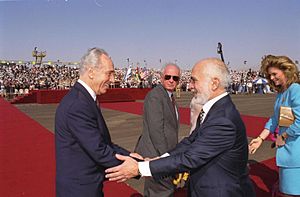
On 26 October 1994, Jordan and Israel signed the Israel–Jordan peace treaty. Prime Minister Yitzhak Rabin and Foreign Minister Shimon Peres had started this process. The signing ceremony took place in Israel, near the Jordanian border. Prime Minister Rabin and Prime Minister Abdelsalam al-Majali signed the treaty. U.S. President Bill Clinton was there to witness it. The treaty ended 46 years of official war between Israel and Jordan. It was only the second full peace agreement Israel had made with an Arab nation. The first was with Egypt in 1978.
Oslo Peace Process with Palestine
Rabin's 1992 election campaign focused on making peace with the Palestinians. Many Israelis supported this idea. Rabin's government began talks with the Yasser Arafat-led Palestine Liberation Organization (PLO).
Peres was involved in secret peace talks between Rabin's government and Arafat's PLO. These talks happened over several months in 1992 and 1993. As part of the talks, Peres secretly flew to Oslo, Norway, in August 1993. The final agreement outlined a peace process between Israel and Palestine. It included setting up a temporary Palestinian government in the Gaza Strip and the West Bank. On 13 September 1993, Peres signed the first Oslo I Accord for Israel at the U.S. White House. Rabin was also there.
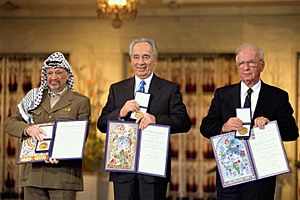
In 1994, Peres, Rabin, and Arafat were jointly awarded the Nobel Peace Prize for their work on the Oslo Accords. This was the second time an Israeli received the Nobel Peace Prize.
Negotiations continued, and Peres remained a key player. On 28 September 1995, Rabin and Arafat signed a second major agreement, known as "Oslo II."
Second Time as Prime Minister (1995–1996)
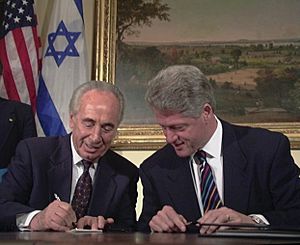
While most Israelis supported the Oslo peace policies, some extreme groups strongly opposed them. On 4 November 1995, a rally was held in Tel Aviv to support the peace process. Both Prime Minister Rabin and Peres attended. After his speech, as Rabin was leaving, he was assassinated by a right-wing Israeli Jew who opposed the peace process.
After Rabin's assassination, Peres became acting prime minister and acting defense minister. On 14 November 1995, the Labor Party confirmed Peres as its new leader. On 21 November, Peres signed an agreement to form a new government, and the Knesset approved it the next day. Peres officially became prime minister.
Peres's second time as prime minister lasted about seven months. During this time, he tried to keep the peace process moving forward.
On 10 February 1996, Peres announced that he would call early elections for late May. He hoped that early elections would give him a strong public mandate to continue working for a two-state solution. Polls at the time showed Peres leading by a large margin. However, his lead began to shrink after some bus bombings in February 1996.
On 11 April 1996, Prime Minister Peres started Operation Grapes of Wrath. This was in response to rockets fired into Israel by Hezbollah. Israel carried out large air raids and shelling in southern Lebanon. Sadly, 106 Lebanese civilians died when a UN compound was hit by Israeli shelling.
In 1996, Peres founded the Peres Center for Peace. This center works to promote lasting peace and progress in the Middle East. It does this by encouraging tolerance, economic and technological development, and cooperation.
During his time as prime minister, Peres also promoted the use of the internet in Israel. He created the first website for an Israeli prime minister.
Labor in Opposition (1996–1999)
Peres was narrowly defeated by Benjamin Netanyahu in the 1996 prime ministerial election. Labor became an opposition party again, and Peres once more took on the unofficial role of Knesset opposition leader.
Peres did not seek re-election as Labor Party leader in 1997. Ehud Barak replaced him that year.
Minister of Regional Cooperation (1999–2001)
Ehud Barak was elected prime minister in 1999 and formed a government. Barak appointed Peres to the less important role of Minister of Regional Cooperation. This job was meant to help improve economic and political ties between Israel and the Arab world.
On 1 November 2000, during the Second Intifada (a period of intense conflict), Peres met with Arafat in the Gaza Strip. They agreed to a truce on behalf of the Israeli government.
After President Ezer Weizman resigned, Peres ran in the 2000 Israeli presidential election. He wanted to be elected by the Knesset members to a seven-year term as Israel's president. This is a ceremonial role. However, he lost to Likud candidate Moshe Katsav. Many thought Peres would win, and his defeat was a big surprise.
Minister of Foreign Affairs (2001–2002)
After Ehud Barak lost to Ariel Sharon in the 2001 election, Peres made another comeback. He helped Labor join a grand coalition government with Sharon's Likud party. Peres became the foreign minister. He was criticized by some on the left for staying in a government that wasn't seen as advancing the peace process, even though he personally supported peace. He left this job when Labor resigned from the government before the 2003 election.
Labor in Opposition (2002–2005)
Peres left his post as foreign minister when Labor left the government in 2002. This put Labor back in opposition.
After the Labor Party lost badly in the 2003 election, Peres became the interim (temporary) leader of the party on 19 June 2003.
Vice Prime Minister (2005)
Peres led the Labor Party into another coalition with Sharon's government in January 2005. This happened because Sharon's plan to withdraw from Gaza was something Labor could support. Sharon made Peres vice prime minister.
As interim party leader, Peres wanted to delay elections as long as possible. He believed an early election would hurt the Gaza withdrawal plan and the party's standing in the unity government. However, most party members wanted an earlier election.
Leaving Labor and Joining Kadima
Peres lost his bid for permanent leadership of the Labor Party to Amir Peretz in November 2005. Peres received 40% of the vote.
Labor left the unity government on 23 November 2005. On 30 November 2005, Peres announced he was leaving the Labor Party to support Ariel Sharon and his new Kadima party. After Sharon suffered a severe stroke, there was talk that Peres might lead Kadima. However, Peres announced he supported Ehud Olmert as Sharon's successor and would stay with Kadima.
Peres had planned not to run in the March 2006 elections but changed his mind. He resigned from the Knesset on 15 January 2006. This was partly because of a rule that would prevent him from running for the next Knesset if he stayed a member after switching parties. By then, he had served in the Knesset for over 46 years without a break.
Peres was soon elected back to the Knesset in the 2006 election, this time as a member of Kadima. In the new Kadima-led government, Peres became vice prime minister and Minister for the Development of the Negev, Galilee and Regional Economy.
President of Israel (2007–2014)
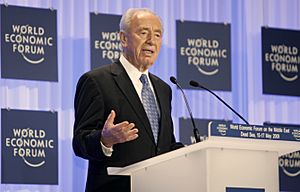
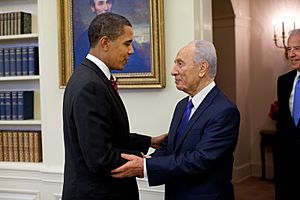
On 13 June 2007, Peres was elected president of the State of Israel by the Knesset. He won with 86 votes in the second round. He resigned from the Knesset the same day. He had been a member since November 1959, making him the longest-serving member in Israeli political history. Peres was sworn in as president on 15 July 2007.
On 20 November 2008, Queen Elizabeth II gave Peres an honorary knighthood in London. In June 2011, Bedouin leaders gave him the honorary title of sheikh for his efforts to bring peace to the Middle East.
Post-Presidency and Death
Peres announced in April 2013 that he would not stay in office beyond 2014. His successor, Reuven Rivlin, was elected on 10 June 2014 and took office on 24 July 2014.
In July 2016, Peres started the 'Israel innovation center' in Jaffa. This center aims to inspire young people worldwide through technology.
On 13 September 2016, Peres suffered a severe stroke and was taken to the hospital. His condition was very serious. Two days later, he was reported to be stable but still serious. However, on 26 September, doctors found irreversible damage to his brain. He died on 28 September at the age of 93.
Tributes and Funeral
Leaders from around the world sent their condolences after his death. Russian President Vladimir Putin said he admired Peres's courage and wisdom. Chinese President Xi Jinping called his death "the loss of an old friend for China." Indian President Pranab Mukherjee said Peres would be remembered as a "steadfast friend of India." U.S. President Barack Obama said he was "grateful that I was able to call Shimon my friend."
The New York Times described Peres as someone who did "more than anyone to build up his country's formidable military might." They also said he worked hard to create lasting peace with Israel's Arab neighbors.
The funeral was held at Mount Herzl in Jerusalem on 30 September 2016. He was buried in the Great Leaders of the Nation section, near former Israeli Prime Ministers Yitzhak Rabin and Yitzhak Shamir.
About 4,000 mourners and world leaders from 75 countries attended the funeral. President Barack Obama gave a speech. This was only the second time Obama traveled overseas for a foreign leader's funeral since Nelson Mandela's. Prime Minister Benjamin Netanyahu also spoke. Other important guests included former President Bill Clinton, Palestinian Authority President Mahmoud Abbas, and leaders from France, Canada, Germany, Mexico, and Spain. The UK delegation included Prince Charles and former Prime Ministers David Cameron, Gordon Brown, and Tony Blair.
Political Views and Legacy
Peres described himself as a "Ben-Gurionist," following his mentor Ben-Gurion. He believed that Jewish self-rule in Israel was a way to achieve progress. He felt Israel could inspire the world and survive in a challenging region.
When he was younger, Peres was seen as a "war hawk" (someone who favors military action). He was a strong supporter of Israeli settlements in the West Bank in the 1970s. However, after becoming party leader, his views changed. He became known as a "dove" (someone who favors peace). He strongly supported peace through economic cooperation. He started to talk about the need for "territorial compromise" over the West Bank and Gaza.
Peres was very closely linked to the Oslo Accords. He remained a strong supporter of these peace agreements and the Palestinian Authority.
Peres's foreign policy was very practical. On the issue of the nuclear program of Iran, Peres said he was not in favor of a military attack. Instead, he wanted a strong group of nations to put economic sanctions on Iran. After his death, it was revealed that Peres had said he prevented a military strike on Iran's nuclear program in 2010.
Peres also supported Middle East economic integration, meaning countries in the region working together economically.
Technology and Innovation
Peres is considered one of the people who helped start Israel's technology sector. He worked with the French government in 1954 to create agreements for nuclear industry cooperation. In 1958, he founded the RAFAEL Armament Development Authority. He oversaw Israel's nuclear program. In the 1980s, he is credited with setting up the economic base for Israel's start-up economy.
In his later years, he became very interested in nanotechnology and brain research. He believed that brain research would lead to a better and more peaceful future. In 2003, he launched his own nanotechnology investment fund. In 2016, he founded the 'Israel innovation center' in Jaffa. This center aims to inspire young people worldwide through technology. When laying its foundation stone, Peres said, "We will prove that innovation has no limits and no barriers. Innovation enables dialogue between nations and between people. It will enable all young people – Jews, Muslims and Christians — to engage in science and technology equally."
Personal Life and Family
In May 1945, Peres married Sonya Gelman. They met at the Ben Shemen Youth Village. Sonya preferred to stay out of the public eye throughout her husband's long political career. She was unable to attend Shimon's presidential inauguration in 2007 due to health issues. When Peres became president, Sonya announced she would stay in their Tel Aviv apartment and not join him in Jerusalem. They lived separately after that. Sonya died on 20 January 2011, at age 87.
Shimon and Sonya Peres had three children. Their oldest child, Dr. Tsvia, became a linguist and professor. Their middle child, Yoni, became a veterinarian who specializes in treating guide dogs. Their youngest child, Nehemia ("Chemi"), co-founded Pitango Venture Capital, one of Israel's largest venture capital funds.
Peres was a cousin of actress Lauren Bacall. They discovered their relation in the 1950s.
Peres spoke many languages: Polish, French, English, Russian, Yiddish, and Hebrew. He never lost his Polish accent when speaking Hebrew.
Poetry and Song-writing
Peres loved writing poetry and songs throughout his life. As a child in Poland, he learned to play the mandolin. He wrote his first song when he was 8. He was known to write poems even during government meetings. He had a deep interest in literature and could quote from Hebrew prophets, French literature, and Chinese philosophy. Many of his poems were turned into songs, and the money from these songs went to charity. Artists like Andrea Bocelli and Liel Kolet have performed his songs. His most recent song, "Chinese Melody," was released in February 2016 to celebrate the Chinese Year of the Monkey.
Places Named After Peres
After his death, it was announced that Israel's Negev nuclear reactor and atomic research center would be named after Peres. Prime Minister Netanyahu stated, "Shimon Peres worked hard to establish this important facility, a facility which has been very important for Israel's security for generations."
Published Works
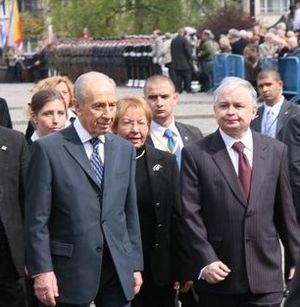
Shimon Peres wrote 11 books, including:
- The Next Step (1965)
- David's Sling (1970)
- The New Middle East (1993)
- Battling for Peace: A Memoir (1995)
- Ben Gurion: A Political Life (2011)
Awards and Recognition
- 1957: Commander of the Legion of Honour (France's highest award).
- 1994, 10 December: Nobel Peace Prize with Yitzhak Rabin and Yasser Arafat.
- 2008, 20 November: Honorary Knight Grand Cross of the Order of St Michael and St George (from Queen Elizabeth II).
- 2012, 13 June: Presidential Medal of Freedom from U.S. President Barack Obama.
- 2014, 19 May: The United States House of Representatives voted to give Peres the Congressional Gold Medal.
- 2015, 31 May: The Solomon Bublick Award from the Hebrew University of Jerusalem.
Overview of Offices Held
Peres officially served as prime minister of Israel twice. His first time was from 1984 to 1986. His second time was from 1995 to 1996. He also served as the unofficial acting prime minister in 1977. Peres was president of Israel from 2007 to 2014. He was a member of the Knesset (Israel's parliament) from 1959 to 2006, and again from 2006 to 2007. His total time in the Knesset, 48 years, is the longest in its history.
Peres was also the leader of the Knesset's opposition four times. For most of these times, it was an unofficial role. His last time in this position was after the role became official.
Labor Party Leadership
Peres served as leader of the Israeli Labor Party three times.
| Tenure | Predecessor | Successor | Knesset elections as leader | Elected/reelected as leader |
|---|---|---|---|---|
| December 1977–February 1992 | Yitzhak Rabin | Yitzhak Rabin | 1977 1981 1984 1988 |
1977 (Apr), 1980, 1984 |
| November 1995–June 1997 | Yitzhak Rabin | Ehud Barak | 1996 | 1995 |
| June 2003–November 2005 (interim leader) | Amram Mitzna | Amir Peretz | 2003 |
Ministerial Posts
Peres held many different ministerial jobs during his time in the Knesset. He held major ministerial posts in twelve governments.
| Ministerial post | Tenure | Prime Minister(s) | Government(s) | Predecessor | Successor |
|---|---|---|---|---|---|
| Deputy Minister of Defense | 21 December 1959 – 25 May 1965 | David Ben-Gurion (until 26 June 1963) Levi Eshkol (after 26 June 1963) |
9, 10 11, 12 | office established | Zvi Dinstein |
| Minister without Portfolio | 15 December 1969 – 22 December 1969 | Golda Meir | 15 | N/A | |
| Minister of Immigrant Absorption | 22 December 1969 – 27 July 1970 | Golda Meir | 15 | Yigal Allon | Natan Peled |
| Minister of Communications | 1 September 1970 – 10 March 1974 | Golda Meir | 15 | Elimelekh Rimalt | Aharon Uzan |
| Minister of Transportation | 1 September 1970 – 10 March 1974 | Golda Meir | 15 | Ezer Weizman | Aharon Yariv |
| Minister of Information | 10 March 1974 – 3 June 1974 | Golda Meir | 16 | office established | Aharon Yariv |
| Minister of Defense (first tenure) | 3 June 1974 – 20 June 1977 | Yitzhak Rabin | 17 | Moshe Dayan | Ezer Weizman |
| Minister of Internal Affairs | 13 September 1984 – 24 December 1984 | Shimon Peres | 21 | Yosef Burg | Yitzhak Peretz |
| Minister of Religious Affairs | 13 September 1984 – 23 December 1984 | Shimon Peres | 21 | Yosef Burg | Yosef Burg⋅ |
| Designated Acting Prime Minister | 20 October 1986 – 15 March 1990 | Yitzhak Shamir | 22, 23 | Yitzhak Shamir | Ehud Olmert (2003) |
| Minister of Foreign Affairs (first tenure) | 20 October 1986 – 23 December 1988 | Yitzhak Shamir | 22 | Yitzhak Shamir | Moshe Arens |
| Minister of Finance | 22 December 1988 – 15 March 1990 | Yitzhak Shamir | 23 | Moshe Nissim | Yitzhak Shamir |
| Minister of Foreign Affairs (second tenure) | 14 July 1992 – 22 November 1995 | Yitzhak Rabin (until 4 November 1995) Shimon Peres (interim after 4 November 1995) |
25 | David Levy | Ehud Barak |
| Minister of Defense (second tenure) | 4 November 1995 – 22 November 1995 (interim minister) 22 November 1995 – 18 June 1996 (permanent minister) |
Shimon Peres (interim PM until 22 November 1995 and permanent PM afterwards) | 25, 26 | Yitzhak Rabin | Yitzhak Mordechai |
| Minister of Regional Cooperation | 6 July 1999 – 7 March 2001 | Ehud Barak | 28 | office established | Tzipi Livni |
| Deputy Prime Minister (serving alongside Silvan Shalom, Natan Sharansky, and Eli Yishai) | 7 March 2001 – 2 November 2002 | Ariel Sharon | 29 | Binyamin Ben-Eliezer | |
| Minister of Foreign Affairs (third tenure) | 7 March 2001 – 2 October 2002 | Ariel Sharon | 29 | Shlomo Ben-Ami | Ariel Sharon |
| Vice Prime Minister (first tenure) | 10 January 2005 – 23 November 2005 | Ariel Sharon | 30 | office established | |
| Vice Prime Minister (second tenure) | 10 January 2006 – 13 June 2007 | Ehud Olmert | 31 | Haim Ramon | |
| Minister for the Development of the Negev, Galilee and Regional Economy | 10 January 2006 – 13 June 2007 | Ehud Olmert | 31 | office established | Yaakov Edri |
Other Offices
From 1952 to 1953, Peres was the deputy director general of the Israeli Ministry of Defense. From 1952 to 1959, he was the director general.
Peres also served as vice president of Socialist International, starting in 1978.
Images for kids
See also
 In Spanish: Shimon Peres para niños
In Spanish: Shimon Peres para niños


